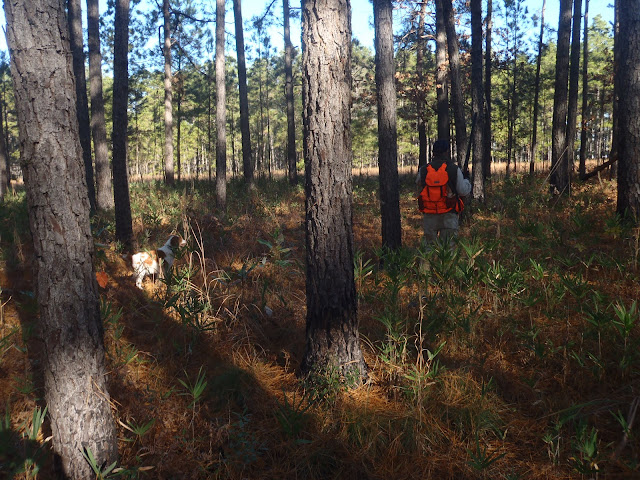I thought 4.5 hours of hard hunting, 39 flushes, and the season’s first covey rise was a pretty good effort. But apparently for Gus, it wasn’t. As I walked back to the car with John Ferguson and Linwood Parker of White Swan Barbeque, I could hear Gus’ beeper collar start to trail off in the distance. He knows which direction the car is parked and what it means when you start walking towards it. That’s when his collar sends out the morse code message, “The hell with this.. There ain’t no birds at the car.” You can’t get angry at a dog who will hunt his brains out. And unfortunately for Gus, that’s exactly what’s happened. I once caught him trying to eat one of my freshly tied white articulated bully streamers. He kept picking it up and spitting it out, confused on why it was biting him back.
In the morning I met John at Wintergreen and waited for Linwood to arrive. John is an avid fly fishermen, so I was glad to talk fishing. And even more glad to hear him say the words February and fly fishing in the same sentence. I was more than willing to listen to someone who has hiked into secluded creeks in search of wild brook trout.
Shortly after Linwood’s arrival, we hit the field.
I hunted with John last season, and as the sun broke through the slotted silhouettes of long leaf pines, he immediately remembered the number of coveys that we busted up late in the afternoon. It is a bird hunters dream to walk the fields with iconic covey calls whistling in the background.
Dixie quickly worked the field, steadily turning back into the wind. This time of year, scent conditions can be as dynamic as a tidal marsh. The cool early morning air clings close to the terrain, but gradually rises with the increasing temperature and humidity. It then returns back to ground with the evening’s cold temperatures, sometimes appearing as frost the following morning. An ebb and flow that continues until Winter decides on a more consistent chill.
Despite Dixie’s efforts, our first hour progressed slowly. We managed to track down a few singles, but our pace left me worried about the number of birds that remained hidden in the brush. We worked our way towards the adjacent field and heard the steady beep of Dixie’s collar as she was locked up on a bird. Linwood walked in on the point.
“I see him on the ground.” Linwood said.
“Wait, there’s two birds, get ready. No, there’s three, no four?!” he continued.
Before he could count to five, the ground erupted with birds. An explosion of feathers and gunpowder followed. Five birds scattered. And Dixie was still locked in on a point.
“There’s still birds in here.” I said.
And as John and Linwood rushed to reload, the ground exploded again. Six more birds got up. In the excitement of trying to take a picture, I dropped my camera, capturing a picture mid-air as it fell to the ground. The second flush caught us all off guard.
“Did you get a mark on any of those birds?” I said.
“Nope.” they replied.
“Well, get ready because Dixie’s still on point.” I said.
A straggler flushed towards the safety of thick timber and dropped on John’s second shot.
The hardest part about shooting over a covey of quail is finding one single target among the countless scattering birds. The overwhelming sight and sound of wings overloads your senses as you try to shoulder your gun. It is a test of nerves and the essence of wing shooting.
We decided to chase down a few singles on the way back to the car and let the remainder of the birds call each other back together. After I switched out dogs, we ended our morning pin pointing covey calls and flushing birds grouped in two’s, three’s and four’s. A classic southern quail hunt.






No comments:
Post a Comment